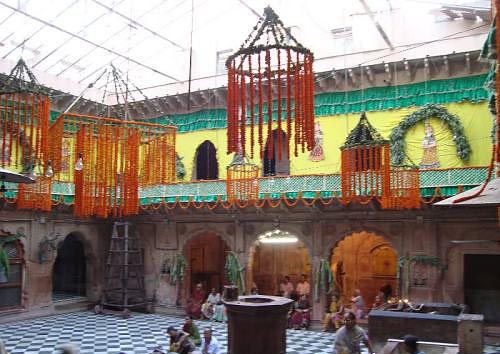Radha Vallabh Temple

Information of Radha Vallabh Temple, Vrindavan, Mathura, Uttar Pradesh
Located nearby the popular Banke Bihari Temple, Radha Vallabha Temple is considered as a significant religious place in Vrindavan to visit. The temple is not only popular for spiritually prone people, but also for usual visitors. Devoted to lord Radha Vallabha faction, Radha Vallabha Temple is one of the most desired sacred places in Vrindavan. It festoons itself with illuminations and colours throughout festival times. A visit to this temple is regarded as an experience worth memorable though the entire life.
Radha Vallabh Temple Religious Significance
Every day several devotees capitulate themselves in the feet of Radha Vallabha. In the fortnight, religious celebration Sanjhitakes place in Radha Vallabha Temple with the temple custom. On that day, the gurus describe the verses of Sanjhi. For the first ten days of fortnight, the idols are decorated with flower and from 11th day to 15th day of dark fortnight, the idols are decorated with coloured powders. The flowery decorations of Radha Vallabha Temple include several acts of Krishna and Radha, known as Leelas. Various foods such as laddos and other sweets are offered to the devotees on that occasion.
The grand festival of Radha Vallabha Temple is Radhastami which celebrate the birthday of goddess Radha. On this occasion, various worshipful songs are sung and kids are outfitted as sacred models of Krishna and Radha. Many band parties play religious melodiesin harmony with the traditional symbols.
The other popular festival in Radha Vallabha Temple is Holi. This festival highlights the appearance of joy and is celebrated with colour. Apart from that, other festivals which are celebrated in Radha Vallabha Temple are Hindora, Khichari, Yugal Darshan and Gulab Dol.
Radha Vallabh Temple Mythology & History
Radha Vallabha is a Vaishnava belief which started withVaishnava theology. This theology has established the Radha Vallabha group. Radha Vallabha focuses on the devotion of lord Krishna towards Radha.The appearance of god Krishna, the re-embodiment of the almighty with entire avatar with his heavenly love groups Radha is a well-accepted fact for Indian people and not a simple legend of Historians. According to Hindu mythology, Radha Vallabha group was originated by Harivamsa Goswami who was a follower of Gopala Bhatta Goswami. Radha Vallabha Temple was constructed for Radha Vallabha group in the year 1626 by a Bengali follower named Sundara Das, the son of Harivamsa Goswami.
Historical records states that the forces of Mughal king Aurangzeb has despoiled Radha Vallabha Temple in the year 1670. Afterwards, a new temple of Radha Vallabhawas constructed. The current temple is close to the old ones and it is the location where the idol of Radha Vallabhawas worshipped. The construction of the new Radha Vallabha Temple was completed in the year 1872. It was stated that during the assault by Mughal king, the idol of Radha Vallabha was shifted to Kaman town for certain period of time and returned in the year 1784.
Radha Vallabh Temple Architectural Significance
Nowadays, there is no idol of Radha Rani in Radha Vallabha Temple. The temple tower itself is worshipped as the idol of Radha Rani, the adoredones of lord Krishna. From dresses to adornments, goddess Radha obtains various offerings from countless devotees all through the year. In Radha Vallabha Temple, there is a crown of goddess Radha which act as a shrine. Devotees irrespective of any caste, faith and religion visit this shrine for giving honour to the spirits of Radha and Krishna.
- Andhra Pradesh Temples
- Assam Temples
- Bihar Temples
- New Delhi Temples
- Goa Temples
- Gujarat Temples
- Jammu and Kashmir Temples
- Karnataka Temples
- Kerala Temples
- Madhya Pradesh Temples
- Maharashtra Temples
- Odisha Temples
- Punjab Temples
- Rajasthan Temples
- Sikkim Temples
- Tamil Nadu Temples
- Telangana Temples
- Uttar Pradesh Temples
- Uttarakhand Temples
- West Bengal Temples